Getting Started
Table of contents
Spring Bot provides a one-stop-shop for constructing complex, chat-platform-agnostic workflows in Java.
In this guide, we’ll put together a workflow in Java for an expenses claim, and demonstrate how it works.
Overview
What Exactly is a Workflow?
A workflow here is a sequence of interactions carried out by a group of users, coordinated with a bot. For example, an expenses workflow might look like this:
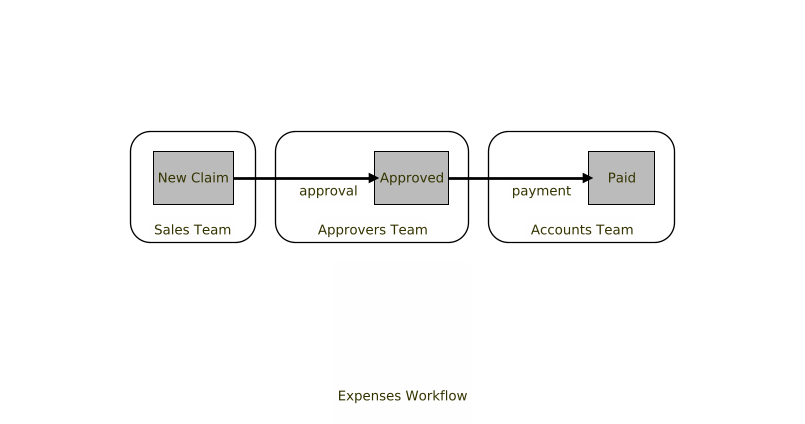
Note - different people are responsible for different actions in the workflow, that move the state of the workflow on.
- User A from the Sales Team raises a claim containing some line-item expenses.
- The claim passes to the Approvers Team, where User B can approve it.
- Then, User C in the Accounts Team_ processes_ the claim and transfers A some money.
How Can A Chat Platform Help?
Chat Platforms like Symphony, Slack or Microsoft Teams are perfect for workflows like this:
-
They support messages containing data. That means, you can keep track of the status of workflow objects within chats on the platform. In the example above, the state of the expense claim can be held in a message as JSON.
-
They support forms. That is, you can present the user a form on screen to be filled, and a button to submit the form.
-
Teams of people can be put together in private rooms. That is, there could be rooms called “Sales Team Room”, “Approvers Team Room” and “Accounts Team Room”. This provides a natural separation of responsibilities: some actions should only be allowed by the participants of some rooms.
-
Bots allow us to provide the interface between a workflow (expressed as Java code) on the one hand, and messages on the platform on the other.
How Can Spring Bot Help?
As we will show in this tutorial, we are going to compose this workflow over different rooms, but those rooms will be on different chat platforms.
- Our Sales Team are going to talk with the bot on Microsoft Teams. The sales teams will talk to the bot there to raise their expense claim.
- Our Approvers will be in a room on Symphony. They will receive the expense claim in their restricted room, where they can approve it.
- The bot will then reply back to the sales team, to let them know their claim was processed.
Building Claim Bot
Create a new Spring Boot project and add the dependencies + configuration for your chat platform.
- For Symphony
If you want to cheat, you can view the code for this here.
1. Creating The NewClaim and OpenedClaim Beans
We’re going to create POJOs to keep track of the claim as it passes through the workflow. For this we will use two classes:
NewClaim: contains the amount, and the description of the claim.OpenedClaim: like aNewClaim, but tracks the status of the claim and the details of any approvers.
It’s not essential for us to split our claim into two classes like this - we could have used a single class with different templates, depending on the state of the claim. But in this tutorial we’re just going to use automatically-generated templates for brevity.
Here is the code for NewClaim.java:
@Work
public class NewClaim {
String description;
@Min(0)
Number amount;
// getters / setters
Note the use of @Min to validate that the user doesn’t enter a negative number in the amount field.
Here’s the code for OpenedClaim.java:
@Work (1)
public class OpenedClaim {
enum Status { OPEN, APPROVED, PAID }; (2)
User author = Action.CURRENT_ACTION.get().getUser(); (3)
User approvedBy; (4)
User paidBy;
@Display(name = "Claim Status") (5)
Status status = Status.OPEN; (7)
String description;
@Min(0)
Number amount;
// getters/setters/ (6)
Notes:
- The
@Workannotation tells Spring Bot that we’re creating a POJO that will be sent as the payload of chat messages. - (&7) Here, we are defining the different states a workflow can be in.
- Assign the author as the person interacting with the bot in this request.
- These fields will track approvals.
- Here, we are using the
@Displayannotation, which instructs the template generator to call the fieldClaim Statuson the screen. - You must provide getters and setters for any properties you want Symphony to store/expose.
Hopefully, all of this will be fairly clear if you are familiar with Java Beans.
2. Allowing Users To Start A Claim
We want the user to be able to type /open, and for the bot to reply with a form, allowing them to start the claim process.
For this, we will need to create a Spring @Controller, with a method annotated with @ChatRequest, like so:
@Controller
public class ClaimController {
@ChatRequest(value = "open", description="Begin New Expense Claim")
@ChatResponseBody(workMode = WorkMode.EDIT)
public NewClaim open(Addressable a) {
return new NewClaim();
}
Note we have also annotated with @ChatResponseBody - this tells Spring Bot to return the form in EDIT mode. i.e. a form for editing.
3. Submitting The Form
So far, we have no way for the user to submit this form. So let’s add a button to it. This goes in ClaimController.java too:
@ChatButton(value = NewClaim.class, buttonText = "add")
public OpenedClaim add(NewClaim sc, User u) {
OpenedClaim c = new OpenedClaim();
c.amount = sc.amount;
c.author = u;
c.description = sc.description;
c.status = Status.OPEN;
return c;
}
Let’s see how that works. When I type /open on Symphony, the Claim Bot responds with a form:

On Microsoft Teams, it looks like this:
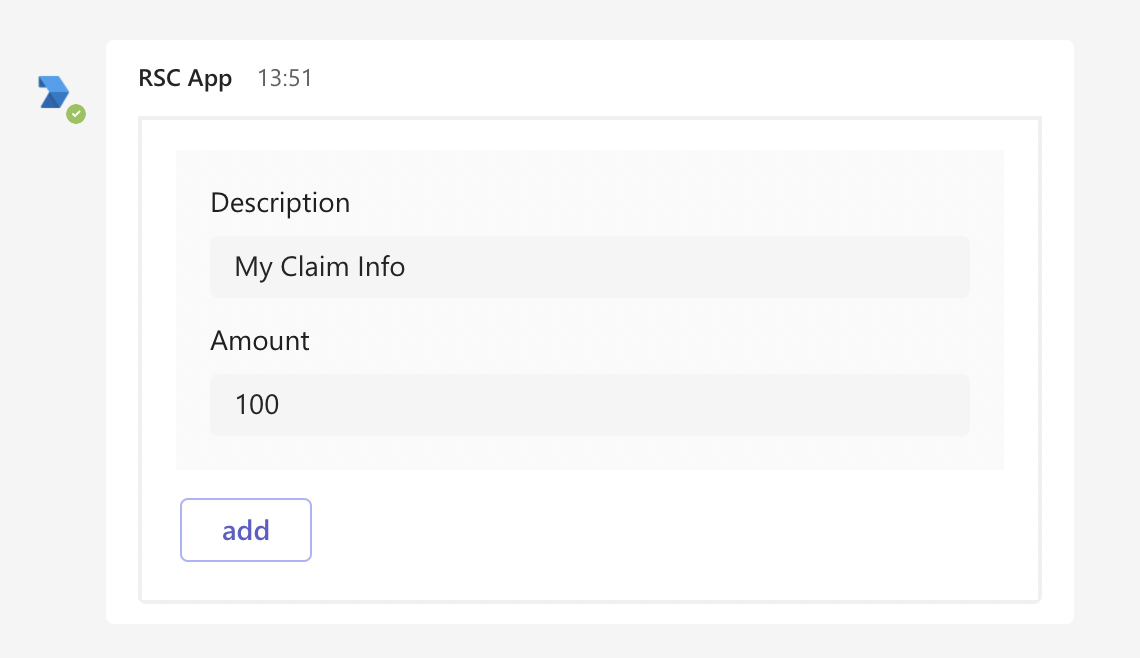
If I get the amount wrong, I have to fix the validation error:

But, if the form validates, the a new OpenedClaim is returned. This is the Symphony view:
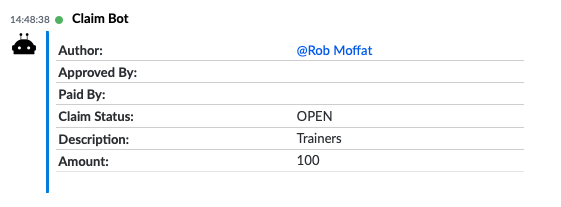
By default, this goes back into our existing room, but we’re going to change that in the next step.
4. Routing
Sending the OpenedClaim back to the room that the NewClaim was created in wasn’t what we wanted. Really, we wanted this to go to our “Approvers Team” for processing, and some kind of note to be placed in the original room saying “your request has been sent for approval”.
But how to represent the Approvers Team? Here are some options:
- We could hard-code a list of email addresses in the application, but that would mean when people moved jobs or roles, we’d have to re-release our code.
- We could have some database somewhere, storing all the roles in it, but this adds another dependency to our application.
- Instead, we could use the features of the chat platform itself, and have a Private Room for the Approvers Team. That way, the administrators of the room can keep the membership up-to-date, and all the members of the room will see all of the
OpenedClaims when they are created.
In Spring Bot, private rooms are represented with Chat objects. We can create Response objects from our add() method to send to the Chat. That means reworking our add() method like so:
@Autowired
AllConversations conversations; (1)
@ChatButton(value = NewClaim.class, buttonText = "add")
public List<Response> add(NewClaim sc, User u, Addressable from) { (2)
OpenedClaim c = new OpenedClaim();
c.amount = sc.amount;
c.author = u;
c.description = sc.description;
c.status = Status.OPEN;
Chat approvalRoom = conversations.getExistingChat("Claim Approval Room"); (3)
return
Arrays.asList(
new WorkResponse(approvalRoom, c, WorkMode.VIEW), (4)
new MessageResponse(from,
Message.of("Your claim has been sent to the Approval Room for processing"))); (5)
}
Notes:
- The
Conversationsbean allows us to look up information about rooms and chats. We can@Autowirethis into our controller. - Here, we’ve added
from, which tells us the user (or direct chat) that originated theNewClaimrequest. - Here, we look up the
Claim Approval Room. Note that if this doesn’t exist, anullwill be returned. - Here, we send our
OpenedClaim,cinto the Approval Room we looked up. When we send around@Workbeans, we put them in aWorkResponse. - Here, we create a
MessageResponseto tell the person that their claim is going to be processed.
In order for this to work, we have to go and create our room on the chat platform, and add both the Claim Bot and the approvers to the room.
5. Approve Button
Let’s add the Approve button to the OpenedClaim form, so that people in the Claim Approval Room can approve the claim. Again, this goes into our ClaimController class:
@ChatButton(value=OpenedClaim.class, buttonText = "Approve", rooms={"Claim Approval Room"})(1)
public List<Response> approve(OpenedClaim c, User currentUser) {
if (c.status == Status.OPEN) { (2)
c.approvedBy = currentUser;
c.status = Status.APPROVED;
return Arrays.asList( (3)
new WorkResponse(c.author, c, WorkMode.VIEW),
new WorkResponse(approvalRoom, c, WorkMode.VIEW));
} else {
throw new RuntimeException("Claim should be in OPEN mode"); (4)
}
}
Notes:
- Here, we are adding a button called
Approveto theOpenedClaimform. Theroomspart of the annotation is a check to make sure the button only appears in theClaim Approval Room. - This is the happy path - when someone presses the
Approvebutton, it sets theapprovedByfield and changes the status. - Approving the claim sends the approved claim to two places - one copy is returned back to the approval room, the other is sent back to the original author of the claim.
- This is the bad path - we throw an exception if the
OpenedClaimis in the wrong state.
Let’s see that happening. Here’s our Claim Approval Room with the OpenedClaim message in it:
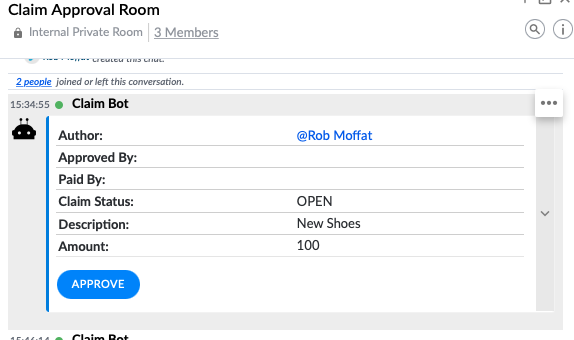
Here it is once we’ve approved it (note the status changes to APPROVED:

And, here’s what happens if we hit the “Approve” button again:

Meanwhile, the orignal author of the claim (who might have created it on Teams) gets their copy:
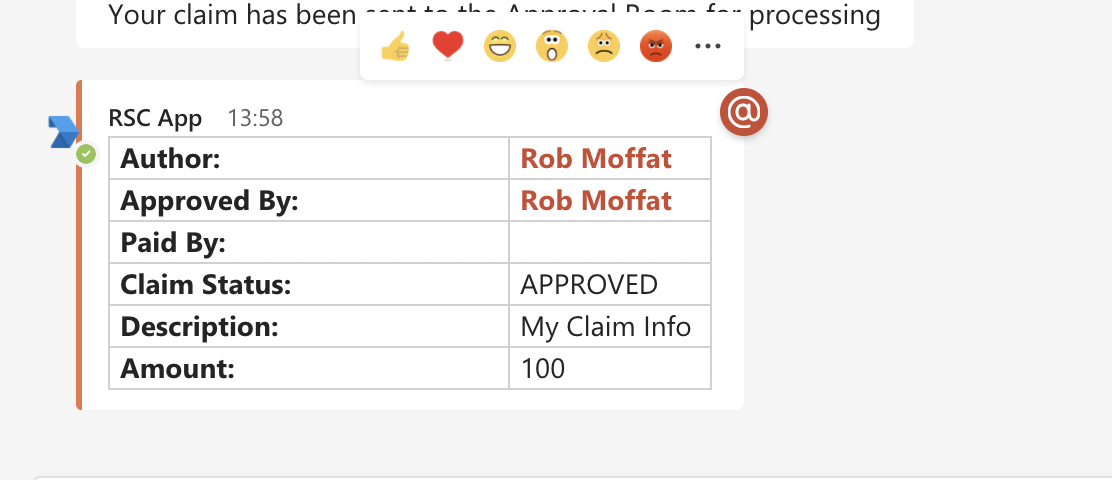
6. Next Steps
Clearly, this shouldn’t be the end of the story.
We’d want the OpenedClaim to be passed into the Accounts Team room next, so that they could perform their part of the workflow.
And, it would be nice to keep the user informed of how their workflow is going - notifying them as it moves along with messages back to the original user.
Hopefully in this short tutorial, you can see how you would achieve these steps.
7. Asking For Help
The bot always supports the user typing /help, which will reveal the commands relevant to the current room (via inspecting the @ChatRequest annotation. e.g.

In Teams this looks like this:
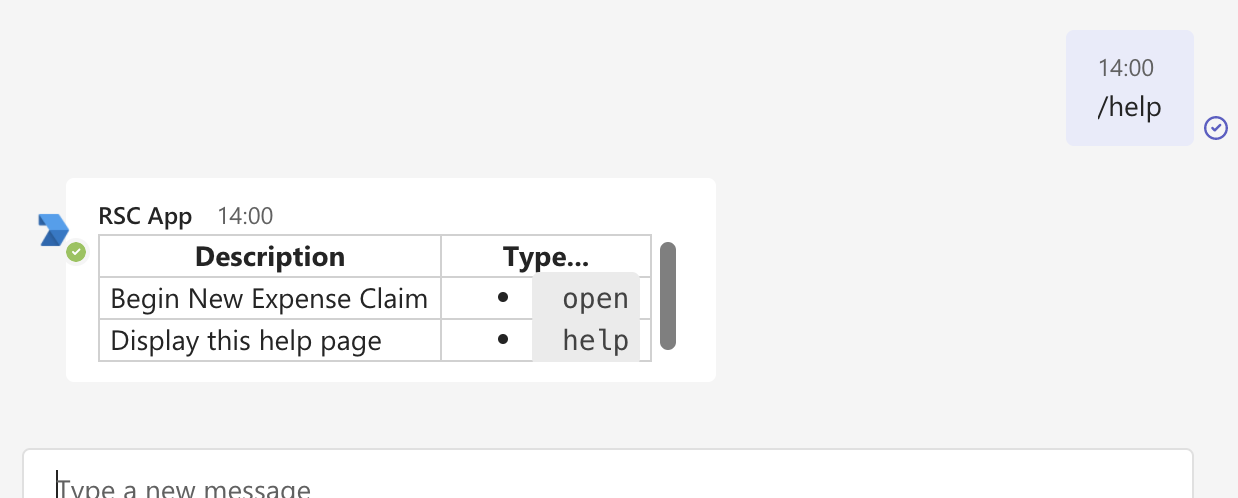
Depending on the arguments of the command, they may be shows as buttons, or suggestions of what to type.